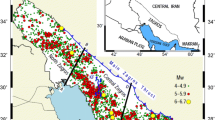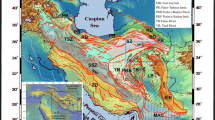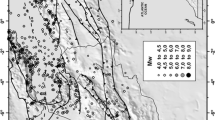Abstract
The Eastern Anatolian Region of Turkey is one of the most seismically and tectonically active regions due to the frequent occurrence of earthquakes. Thus, the main goal of this study is to analyze the regional and temporal characteristics of seismicity in the Eastern Anatolia in terms of the seismotectonic b-value, fractal dimension Dc-value, precursory seismic quiescence Z-value, and their interrelationships. This study also seeks to obtain a reliable empirical relation between b and Dc-values and to evaluate the temporal changes of these parameters as they relate to the earthquake potential of the region. A more up-to-date relation of Dc = 2:55–0:39*b is found with a very strong negative correlation coefficient (r =–0.95) by using the orthogonal regression method. The b-values less than 1.0 and the Dc-values greater than 2.2 are observed in the Northeast Anatolian Fault Zone, Aşkale, Erzurum, Iğdır and Çaldıran Faults, Doğubeyazıt Fault Zone, around the Genç Fault, the western part of the Bitlis-Zagros Thrust Zone, Pülümür and Karakoçan Faults, and the Sancak- Uzunpınar Fault Zone. In addition, the regions having small b-values and large Z-values are calculated around the Genç, Pülümür and Karakoçan Faults as well as the Sancak-Uzunpınar Fault Zone. Remarkably, the combinations of these seismotectonic parameters could reveal the earthquake hazard potential in the Eastern Anatolian Region of Turkey, thus creating an increased interest in these anomaly regions.
Similar content being viewed by others
References
Aki K (1965). Maximum likelihood estimate of b in the formula logN = a–bM and its confidence limits. Bull Earthq Res Inst Univ Tokyo, 43: 237–239
Aki K (1981). A probabilistic synthesis of precursory phenomena. In: Simpson D W, Richards P G, eds. Earthquake Prediction: An International Review. Maurice Ewing Series. AGU,Washington, DC, 4: 566–574
Arabasz W J, Hill S J (1996). Applying Reasenberg’s cluster analysis algorithm to regional earthquake catalogs outside California. Seismol Res Lett, 67(2): 30 (abstract)
Barton D J, Foulger G R, Henderson J R, Julian B R (1999). Frequencymagnitude statistics and spatial correlation dimensions of earthquakes at Long Valley Caldera, California. Geophys J Int, 138(2): 563–570
Bayrak Y, öztürk S, Çinar H, Kalafat D, Tsapanos T M, Koravos G Ch, Leventakis G A (2009). Estimating earthquake hazard parameters from instrumental data for different regions in and around Turkey. Eng Geol, 105(3–4): 200–210
Bozkurt E (2001). Neotectonics of Turkey-a synthesis. Geodin Acta, 14 (1–3): 3–30
Carrol R J, Ruppert D (1996). The use and misuse of orthogonal regression estimation in linear errors-in-variables models. Am Stat, 50: 1–6
Chen C C, Wang W C, Chang Y F, Wu Y M, Lee Y H (2006). A correlation between the b-value and the fractal dimension from the aftershock sequence of the 1999 Chi-Chi, Taiwan, earthquake. Geophys J Int, 167(3): 1215–1219
Console R, Montuori C, Murru M (2000). Statistical assessment of seismicity patterns in Italy: are they precursors of subsequent events? Earth Planets Space, 4(4): 435–449
Enescu B, Ito K (2002). Spatial analysis of the frequency-magnitude distribution and decay rate of aftershock activity of the 2000 Western Tottori earthquake. Earth Planets Space, 54(8): 847–859
Erdik M, Alpay B Y, Onur T, Sesetyan K, Birgoren G (1999). Assessment of earthquake hazard in Turkey and neighboring regions. Ann Geofis, 42: 1125–1138
Frohlich C, Davis S (1993). Teleseismic b-values: or, much ado about 1.0. J Geophys Res, 98(B1): 631–644
Goltz C (1998). Fractal and chaotic properties of earthquakes (Lecture Notes in Earth Sciences, 77). Springer-Verlag, 178 pp
Grassberger P, Procaccia I (1983). Measuring the strangeness of strange attractors. Physica, 9(D): 189–208
Gutenberg R, Richter C F (1944). Frequency of earthquakes in California. Bull Seismol Soc Am, 34: 185–188
Hempton M R (1987). Constraints on Arabian plate motion and extensional history of the Red Sea. Tectonics, 6(6): 687–705
Hirabayashi T, Ito K, Yoshii T (1992). Multifractal analysis of earthquakes. Pure Appl Geophys, 138(4): 591–610
Hirata T (1989a). Correlation between the b-value and the fractal dimension of earthquakes. J Geophys Res, 94(B6): 7507–7514
Hirata T (1989b). Fractal dimension of fault systems in Japan: fractal structure in rock fracture geometry at various scales. Pure Appl Geophys, 131(1–2): 157–170
Kagan Y Y (2007). Earthquake spatial distribution: the correlation dimension. Geophys J Int, 168(3): 1175–1194
Katsumata K, Kasahara M (1999). Precursory seismic quiescence before the 1994 Kurile Earthquake (Mw = 8.3) revealed by three independent seismic catalogs. Pure Appl Geophys, 155(2–4): 443–470
Kember G, Fowler A C (1992). Random sampling and the Grassberger-Procaccia algorithm. Phys Lett A, 161(5): 429–432
Mandelbrot B B (1982). The Fractal Geometry of Nature. San Francisco: Freeman Press
Matcharashvili T, Chelidze T, Javakhishvili Z (2000). Nonlinear analysis of magnitude and interevent time interval sequences for earthquakes of Caucasian region. Nonlinear Process Geophys, 7(1/2): 9–20
Mogi K (1967). Earthquakes and fractures. Tectonophysics, 5(1): 35–55
Mogi K (1969). Some features of recent seismic activity in and near Japan. 2. Activity before and after great earthquakes. Bull Earthq Res Inst Univ Tokyo, 47: 395–417
Mori J, Abercrombie R E (1997). Depth dependence of earthquake frequency-magnitude distribution in California: implications for the rupture initiation. J Geophys Res, 102(B7): 15081–15090
öncel A O, Alptekin Ö, Main I G (1995). Temporal variations of the fractal properties of seismicity in the western part of the North Anatolian fault zone: possible artifacts due to improvements in station coverage. Nonlinear Process Geophys, 2(3/4): 147–157
Öncel A O, Main I G, Alptekin Ö, Cowie P A (1996). Temporal variations of the fractal properties of seismicity in the north Anatolian fault zone between 31°E and 41°E. Pure Appl Geophys, 146: 148–159
Öncel A O, Wilson T H (2002). Space-time correlations of seismotectonic parameters and examples from Japan and Turkey preceding the Izmit earthquake. Bull Seismol Soc Am, 92(1): 339–349
Öncel A O, Wilson T H (2004). Correlation of seismotectonic variables and GPS strain- measurements in western Turkey. J Geophys Res, 109(B11): B11306
Öncel A O, Wilson T H (2007). Anomalous seismicity preceding the 1999 Izmit event, NW Turkey. Geophys J Int, 169(1): 259–270
Ouillon G, Sornette D, Castaing C (1995). Organisation of joints and faults from 1-cm to 100-km scales revealed by optimized anisotropic wavelet coefficient method and multifractal analysis. Nonlinear Process Geophys, 2(3/4): 158–177
Öztürk S (2009). An application of the earthquake hazard and aftershock probability evaluation methods to Turkey earthquakes. Dissertation for PhD degree. Karadeniz Technical University, Trabzon, Turkey (in Turkish with English abstract)
Öztürk S (2011). Characteristics of seismic activity in the western, central and eastern parts of the North Anatolian Fault Zone, Turkey: temporal and spatial analysis. Acta Geophysica, 59(2): 209–238
Öztürk S (2012). Statistical correlation between b-value and fractal dimension regarding Turkish epicentre distribution. Earth Sciences Research Journal, 16(2): 103–108
Öztürk S (2013). A statistical assessment of current seismic quiescence along the North Anatolian Fault Zone: earthquake precursors. Mitt Osterr Geol Ges, 106(2): 4–17
Öztürk S (2015). A study on the correlations between seismotectonic bvalue and Dc-value, and seismic quiescence Z-value in the Western Anatolian region of Turkey. Mitt Osterr Geol Ges, 108(2): 172–184
Öztürk S, Bayrak Y (2012). Spatial variations of precursory seismic quiescence observed in recent years in the eastern part of Turkey. Acta Geophysica, 60(1): 92–118
Öztürk S, Bayrak Y, Çinar H, Koravos G Ch, Tsapanos T M (2008). A quantitative appraisal of earthquake hazard parameters computed from Gumbel I method for different regions in and around Turkey. Nat Hazards, 47(3): 471–495
Polat O, Gok E, Yilmaz D (2008). Earthquake hazard of the Aegean Extension region (West Turkey). Turk J Earth Sci, 17: 593–614
Prasad S, Singh C (2015). Evolution of b-values before large earthquakes of mb=6.0 in the Andaman region. Geol Acta, 13(3): 205–210
Reasenberg P A (1985). Second-order moment of Central California seismicity, 1969–1982. J Geophys Res, 90(B7): 5479–5495
Roy S, Ghosh U, Hazra S, Kayal J R (2011). Fractal dimension and bvalue mapping in the Andaman-Sumatra subduction zone. Nat Hazards, 57(1): 27–37
Saroglu F, Emre O, Kuscu O (1992). Active fault map of Turkey. General Directorate of Mineral Research and Exploration, Ankara, Turkey
Sengör A M C, Yilmaz Y (1981). Tethyan evolution of Turkey: a plate tectonic approach. Tectonophysics, 75: 181–241
Smith L A (1988). Intrinsic limits on dimension calculations. Phys Lett A, 133(6): 283–288
Teotia S S, Kumar D (2007). The Great Sumatra-Andaman earthquake of 26 December 2004 was predictable even from seismicity data of mb>4.5: a lesson to learn from natüre. Indian J Mar Sci, 36(2): 122–127
Wiemer S (2001). A software package to analyze seismicity: ZMAP. Seismol Res Lett, 72(3): 373–382
Wiemer S, Katsumata K (1999). Spatial variability of seismicity parameters in aftershock zones. J Geophys Res, 104(B6): 13,135–13,151
Wiemer S, Wyss M (1994). Seismic quiescence before the Landers (M = 7.5) and Big Bear (6.5) 1992 earthquakes. Bull Seismol Soc Am, 84(3): 900–916
Wiemer S, Wyss M (2000). Minimum magnitude of completeness in earthquake catalogs: examples from Alaska, the Western United States, and Japan. Bull Seismol Soc Am, 90(4): 859–869
Woessner J, Wiemer S (2005). Assessing the quality of earthquake catalogs: estimating the magnitude of completeness and its uncertainty. Bull Seismol Soc Am, 95(2): 684–698
Wu Y M, Chiao Y L (2006). Seismic quiescence before the 1999 Chi- Chi, Taiwan, MW7.6 Earthquake. Bull Seismol Soc Am, 96(1): 321–327
Wyss M, Burford R O (1987). Occurrences of predicted earthquake on the San Andreas fault. Nature, 329(6137): 323–325
Wyss M, Klein F, Nagamine K, Wiemer S (2001). Anomalously high bvalues in the south flank of Kilauea volcano: evidence for the distribution of magma below Kilauea’s East Rift Zone. J Volcanol Geotherm Res, 106(1–2): 23–37
Wyss M, Martirosyan A H (1998). Seismic quiescence before the M7, 1988, Spitak earthquake, Armenia. Geophys J Int, 134(2): 329–340
Wyss M, Sobolev G A, Clippard J D (2004). Seismic quiescence precursors to two M7 earthquakes on Sakhalin Island, measured by two methods. Earth Planets Space, 56(8): 725–740
Acknowledgements
The author would like to thank Prof. Dr. Stefan Wiemer for providing ZMAP software and the anonymous reviewers for their useful and constructive suggestions to improve this paper. I am grateful to Prof. Dr. Dogan Kalafat (KOERI) for providing the earthquake catalog.
Author information
Authors and Affiliations
Corresponding author
Rights and permissions
About this article
Cite this article
Öztürk, S. Earthquake hazard potential in the Eastern Anatolian Region of Turkey: seismotectonic b and Dc-values and precursory quiescence Z-value. Front. Earth Sci. 12, 215–236 (2018). https://doi.org/10.1007/s11707-017-0642-3
Received:
Accepted:
Published:
Issue Date:
DOI: https://doi.org/10.1007/s11707-017-0642-3




